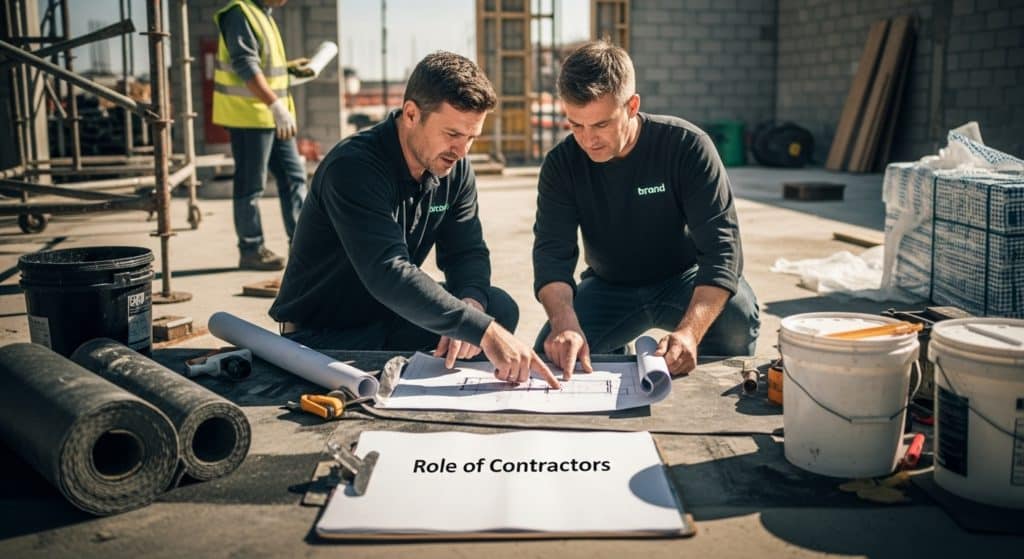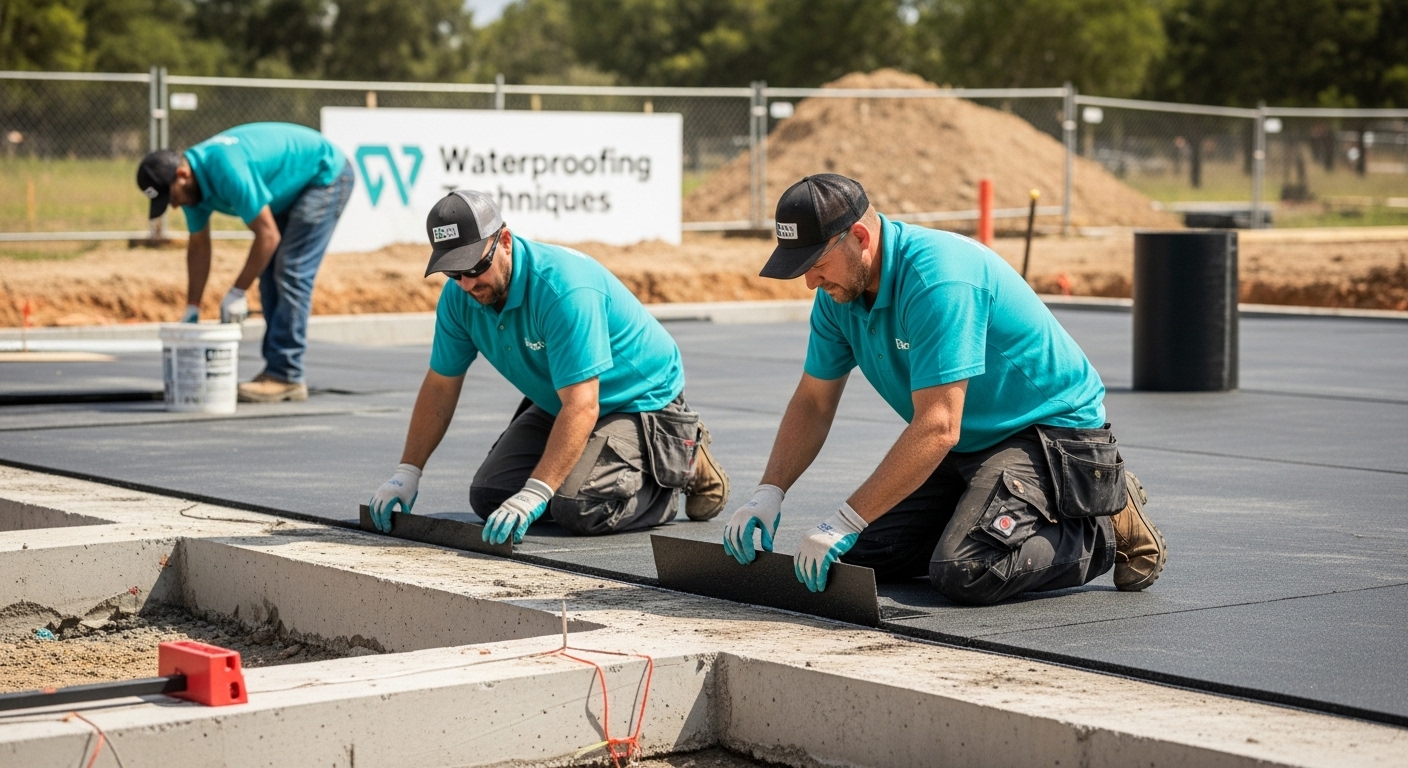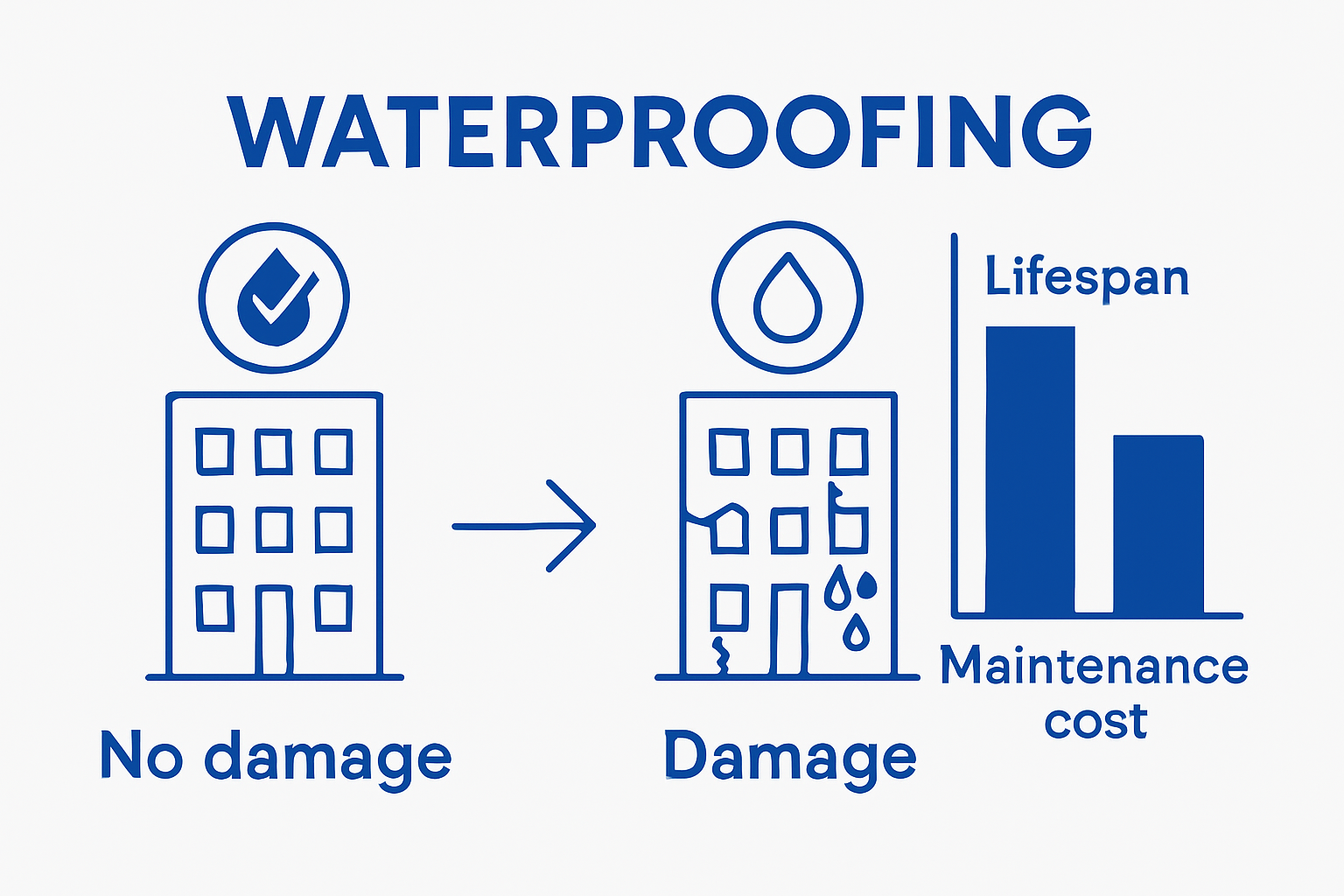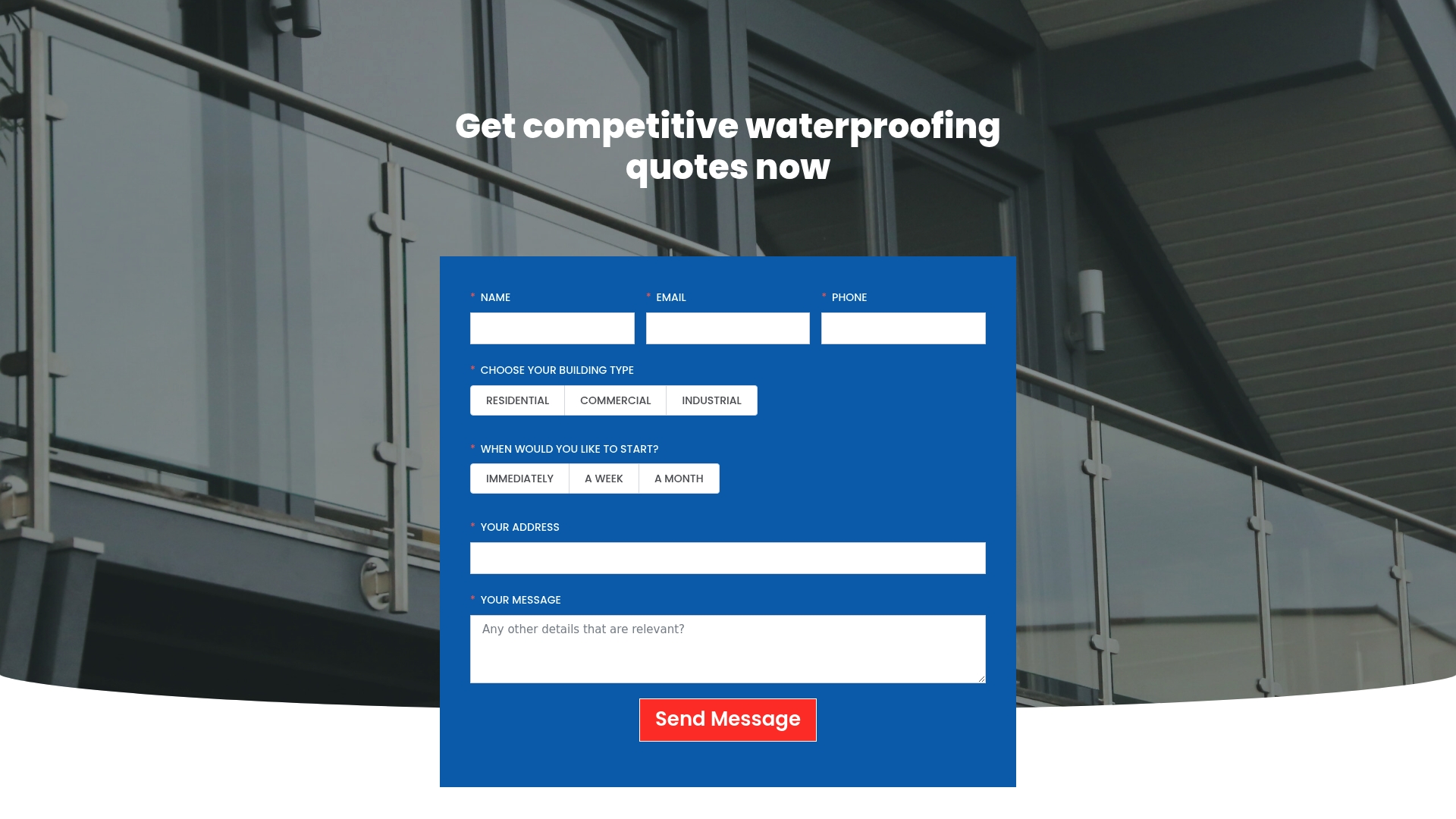Every building stands firm until water starts creeping in, risking everything from foundations to the very air you breathe indoors. Most people think a quick coat of sealant will do the trick and keep their walls safe. Yet studies show that professional waterproofing, done right, can stretch a building’s lifespan by up to 50 years. That single decision changes everything about how your property ages and what hidden costs might hit you down the line.
Table of Contents
- Defining Waterproofing And Its Importance In Construction
- The Responsibilities Of Contractors In Waterproofing Projects
- Materials And Techniques Used By Contractors In Waterproofing
- Challenges Faced By Contractors In Waterproofing Applications
- The Impact Of Quality Waterproofing On Property Longevity
Quick Summary
| Takeaway | Explanation |
|---|---|
| Waterproofing is essential for building protection | It prevents water damage, which can lead to structural deterioration and increased maintenance costs. |
| Contractors must assess moisture vulnerabilities | Comprehensive site evaluations identify water entry points and existing damage for tailored waterproofing solutions. |
| Material selection significantly affects performance | Choosing appropriate waterproofing materials can reduce water-related damage by up to 75% and enhance building longevity. |
| Quality waterproofing enhances property value | Effective waterproofing extends a property’s lifespan by up to 30 years and reduces maintenance expenditure by approximately 60%. |
| Stay updated with regulations and standards | Contractors need to comply with evolving industry standards to ensure optimal waterproofing performance and project success. |
Defining Waterproofing and Its Importance in Construction
Waterproofing represents a critical protective strategy in construction that prevents water penetration and moisture damage to buildings and structures. At its core, waterproofing involves applying specialised materials and techniques to create an impermeable barrier that shields structural components from potential water intrusion.
The Fundamental Purpose of Waterproofing
The primary objective of waterproofing is to protect buildings from water damage, which can lead to significant structural deterioration. Water infiltration can cause numerous problems, including:
- Compromising structural integrity
- Creating environments conducive to mould and fungal growth
- Causing wood rot and metal corrosion
- Reducing overall building lifespan
- Generating substantial repair and maintenance expenses
Understanding building waterproofing techniques requires recognising that different construction areas demand unique protective strategies. These areas include foundations, roofs, walls, basements, and underground structures.
Critical Components of Effective Waterproofing
Successful waterproofing integrates multiple components designed to repel and redirect water. These typically include waterproof membranes, sealants, drainage systems, and protective coatings that work synergistically to prevent moisture penetration. Research from the International Construction Waterproofing Association indicates that comprehensive waterproofing strategies can extend a building’s functional life by up to 50 years when implemented correctly.
Contractors play an essential role in selecting appropriate waterproofing methods tailored to specific environmental conditions, building materials, and structural requirements. Their expertise ensures that waterproofing solutions are not just applied, but strategically integrated into the overall construction design.
The Responsibilities of Contractors in Waterproofing Projects
Waterproofing contractors are specialised professionals who play a critical role in protecting buildings from water damage. Their responsibilities extend far beyond simple application of waterproofing materials, encompassing comprehensive assessment, strategic planning, and precise implementation of protective solutions.
Comprehensive Site Assessment and Analysis
Before initiating any waterproofing project, contractors must conduct thorough site evaluations to determine the specific moisture challenges and structural vulnerabilities. This comprehensive assessment involves:
- Identifying potential water entry points
- Evaluating existing moisture damage
- Analyzing soil conditions and drainage patterns
- Assessing structural materials and their water resistance
- Determining appropriate waterproofing techniques
Questions to ask contractors during project planning become crucial in understanding their approach and expertise in handling complex waterproofing challenges.
Technical Implementation and Material Selection
Contractors must demonstrate advanced technical knowledge in selecting and applying appropriate waterproofing materials. Research from the Construction Waterproofing Professionals Association indicates that proper material selection can reduce water-related structural damage by up to 75%. Their responsibilities include:
- Recommending suitable waterproofing membranes
- Applying sealants with precision
- Installing drainage systems
- Ensuring proper surface preparation
- Guaranteeing comprehensive coverage and protection
Moreover, waterproofing contractors must stay updated with the latest technological advancements and regulatory standards to provide optimal protection for different structures and environments.
Materials and Techniques Used by Contractors in Waterproofing
Waterproofing contractors leverage a sophisticated array of materials and techniques to create robust protection against moisture penetration. Their approach involves selecting specialised solutions that address specific structural vulnerabilities and environmental challenges.
Waterproofing Material Spectrum
Contractors utilise diverse materials designed to provide comprehensive moisture barriers. These materials are engineered to withstand different environmental conditions and structural requirements
Below is a table summarising key waterproofing materials used by contractors, along with their typical applications and advantages.
| Material | Typical Applications | Key Advantages |
|---|---|---|
| Bituminous membranes | Roofs, basements, foundations | High durability, effective moisture barrier |
| Liquid-applied compounds | Bathrooms, balconies, roofs | Seamless finish, flexible application |
| Cementitious coatings | Water tanks, internal walls, basements | Simple application, strong adhesion |
| Polyurethane sealants | Joints, cracks, external walls | Excellent flexibility, UV resistance |
| Crystalline treatments | Concrete structures, foundations | Self-sealing properties, long-term protection |
| : |
- Bituminous membranes
- Liquid-applied waterproofing compounds
- Cementitious coatings
- Polyurethane sealants
- Crystalline waterproofing treatments
Exterior basement waterproofing techniques demonstrate the complexity of selecting appropriate materials for different structural elements and environmental contexts.
Advanced Application Techniques
Modern waterproofing extends beyond simple material application. Contractors employ sophisticated techniques that ensure complete and long-lasting protection. Research from the National Waterproofing Association reveals that strategic application can improve moisture resistance by up to 85%.
Contractors must understand the intricate relationships between materials, application methods, and specific structural requirements. Their expertise involves:
- Precise surface preparation
- Understanding thermal expansion properties
- Evaluating substrate compatibility
- Managing environmental moisture dynamics
- Implementing multi-layered protection strategies
The success of waterproofing depends not just on material quality, but on the contractor’s technical skill and comprehensive understanding of moisture management principles.
Challenges Faced by Contractors in Waterproofing Applications
Waterproofing contractors navigate a complex landscape of technical, environmental, and regulatory challenges that demand exceptional expertise and adaptive problem-solving skills. These challenges require sophisticated approaches to ensure comprehensive moisture protection across diverse structural environments.
Technical and Environmental Complexity
Contractors encounter multifaceted challenges that test their technical capabilities and strategic thinking. Each project presents unique obstacles that require precise diagnostic and remediation strategies:
The following table highlights common technical and environmental challenges faced by waterproofing contractors, alongside their implications on project delivery.
| Challenge | Description | Impact on Projects |
|---|---|---|
| Unpredictable geological conditions | Subsurface water movement, soil variability | Increases diagnostic complexity |
| Varying substrate compositions | Differences in construction materials | Affects material compatibility |
| Extreme temperature fluctuations | High/low temperature cycles | Can cause material failure |
| Complex architectural designs | Non-standard shapes, tight spaces | Requires customised solutions |
| Conflicting material interactions | Chemical or physical incompatibility | May compromise system integrity |
- Unpredictable geological conditions
- Varying substrate compositions
- Extreme temperature fluctuations
- Complex architectural designs
- Conflicting building material interactions
Understanding potential contractor limitations becomes crucial in managing expectations and developing robust waterproofing solutions.
Regulatory and Performance Constraints
Waterproofing professionals must navigate stringent industry standards and building regulations that continuously evolve. Research from the International Construction Standards Council indicates that compliance challenges can increase project complexity by up to 40%.
Contractors must consistently demonstrate their ability to:
- Meet strict building code requirements
- Provide comprehensive warranty coverage
- Implement scientifically validated techniques
- Document detailed project specifications
- Maintain rigorous quality control protocols
The most successful waterproofing contractors distinguish themselves through their ability to transform technical challenges into comprehensive, long-lasting moisture protection solutions.
The Impact of Quality Waterproofing on Property Longevity
Quality waterproofing represents a critical investment in property preservation, offering far-reaching benefits that extend beyond immediate moisture protection. Professional contractors understand that comprehensive waterproofing directly correlates with a building’s structural integrity, maintenance costs, and overall market value.
Structural Preservation and Damage Prevention
Effective waterproofing acts as a comprehensive shield against progressive structural deterioration. Water infiltration can cause extensive damage that compounds over time, compromising fundamental building components:
- Preventing foundation erosion
- Mitigating concrete degradation
- Protecting reinforcing steel from corrosion
- Reducing potential structural settlement
- Maintaining load-bearing capacity
Waterproofing is not a negotiable aspect of property maintenance, representing a strategic approach to long-term asset protection.
Economic and Value Preservation Implications
Research from the Building Research Establishment demonstrates that proactive waterproofing can extend a property’s functional lifespan by up to 30 years and reduce maintenance expenditure by approximately 60%. Contractors play a pivotal role in delivering these substantial economic benefits through:
- Implementing advanced moisture barrier technologies
- Conducting comprehensive site assessments
- Recommending tailored waterproofing strategies
- Ensuring precise application techniques
- Providing extended warranty coverage
The most successful waterproofing interventions transform potential structural vulnerabilities into robust, resilient building systems that withstand environmental challenges and time-related degradation.
Take the Stress Out of Waterproofing with Trusted Contractors
Too often, property owners face costly repairs and long-term headaches because the right waterproofing solutions were not put in place from the start. As explored in this article, relying on qualified contractors and proven materials makes all the difference in protecting your building’s future. If you have ever questioned whether your foundations or walls are truly moisture-proof, you are not alone. Many discover too late how gaps in technical skill, assessment, or compliance can compromise the integrity of their space. Protecting your asset begins with guidance and expertise you can trust from the very first consultation. Discover more useful insights on our expertise page and understand how to make informed choices for your site.
Ready to secure your property against water damage? Do not wait until the first signs of damp or visible deterioration appear. Connect directly with Pro Waterproofing today for a tailored assessment and expert solutions from certified contractors. Make your next waterproofing project a success story, not a liability. Enquire now to safeguard your investment with confidence.
Frequently Asked Questions
What is the primary purpose of waterproofing in construction?
The primary purpose of waterproofing is to prevent water infiltration and protect buildings from moisture damage, which can compromise structural integrity and lead to costly repairs.
What responsibilities do contractors have in waterproofing projects?
Contractors are responsible for conducting comprehensive site assessments, selecting appropriate waterproofing materials, implementing effective techniques, and ensuring that all work complies with relevant building regulations.
What types of materials are commonly used in waterproofing?
Common waterproofing materials include bituminous membranes, liquid-applied compounds, cementitious coatings, polyurethane sealants, and crystalline treatments, each designed for specific structural vulnerabilities and environmental conditions.
What challenges do waterproofing contractors face during projects?
Contractors face challenges such as unpredictable geological conditions, varying substrate compositions, extreme weather fluctuations, and the need to comply with stringent building regulations.




